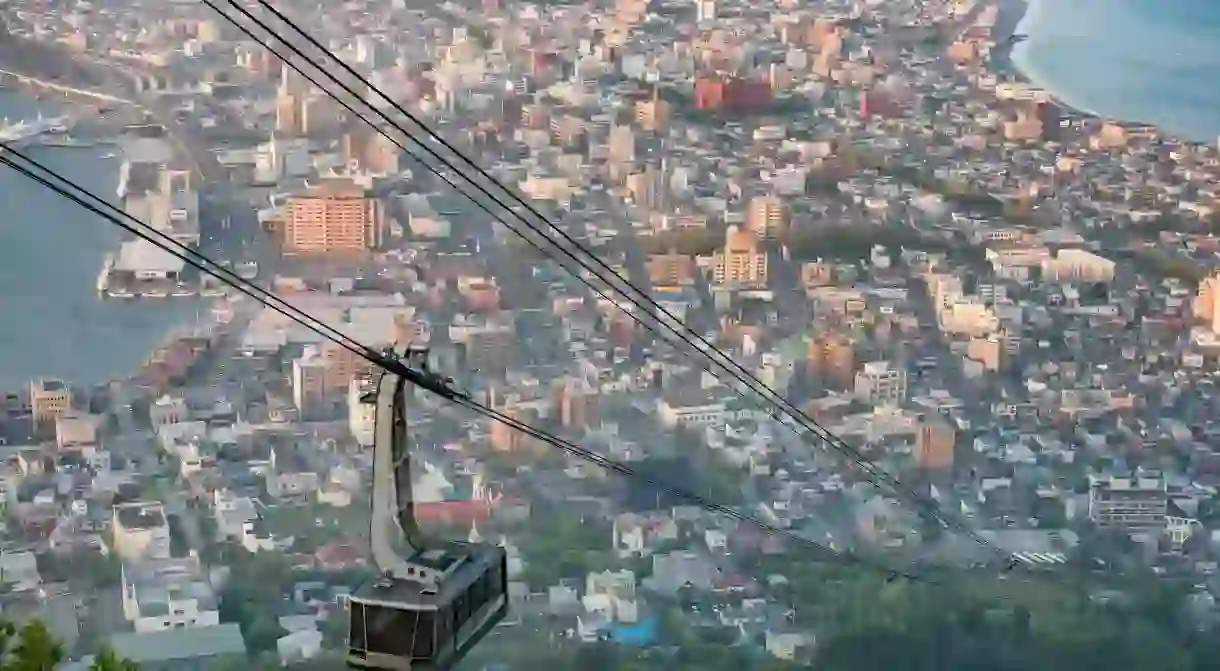A Complete Guide to Hokkaido’s Mount Hakodate

Looming above this gateway to southern Hokkaido like a crown atop a head, Mount Hakodate represents the defining natural feature of this historic port city on the Oshima Peninsula. Hakodate’s iconic peak peers 334 metres (1,096 feet) above the streets below, supplying spectacular vistas of this waterfront metropolis.
The view from Mount Hakodate is so good that the Michelin Green Guide deemed the landmark worthy of three stars – the highest possible rating – and anointed it one of Japan’s most impressive vantage points, trailing only Mount Inasa in Nagasaki’s city centre and Mount Rokko’s panoramic views over Kobe and Osaka. And on top of its peerless panorama, the mountain itself is peppered with tea rooms, temples and time-ravaged forts that make it much more than just a photo op. Read on for everything visitors need to know about Mount Hakodate.
At the summit
Hakodate’s city centre is sandwiched between two vast bodies of water – Hakodate Bay and the Tsugaru Strait – which makes for a particularly dazzling outlook after dark, as sparkling lights are bookended by two curves of pitch-black ocean. Visit on a weekday to catch the twinkliest skyline, or ascend the mountain on a clear day to see even further. The view changes with the calendar: the crisp autumn air offers the best visibility, the city is dusted with lily-white snow during winter, a balmy haze shimmers in summer and pink petals pop up during spring’s sakura season.
At the 334-metre-tall (1,096-foot-tall) summit, the free-of-charge modern observatory invites visitors into its observation decks, souvenir stores and eateries. The top-level lookout sits at the very top, crowded with visitors at sunset (around 7pm in the warmer months), while there’s a more spacious promenade below. On the second level, Restaurant Genova’s floor-to-ceiling windows complement the Western and Japanese cuisine on the plate, and the views are even better from the Tea Lounge Legato one floor higher up. There’s also an event hall used for concerts and movie screenings, a pair of souvenir shops – pick up a Kita-Usagi knick-knack, the rabbit-themed mascot of the city – and a takeout store serving ice cream, coffee, beer and light meals to enjoy with the views.
A stroll past the Azumaya observation deck on the back side of the observatory lives the ruins of a World War II-era gun emplacement. The fortress was built in the 1920s before a pair of howitzers rolled in during the 1940s. The tunnels and turrets have decayed after the conflict, but the ruins remain for intrepid urban explorers. A pair of circular tables with benches now sit where the mammoth artillery used to, and much further down the slope lies a second battery for war buffs to check out, too.

Get to the top
The most common way of scaling Mount Hakodate is the scenic ropeway that zooms to the top in just three minutes. The cable car departs from the Motomachi district – a trove of European-style architecture where merchants built their lives when Hakodate opened its port to the world in the 1850s, turning the city into one of the premier trading hubs in northern Japan – from a station a 10-minute walk from the Jujigai tram stop. Services run every 15 minutes from 10am to 10pm in the warmer months (until 9pm October to April) – sunset journeys are most crowded – and the trip costs ¥1,000 (£7.47) one-way or ¥1,500 (£11.20) return.
There are no chairs in the carriage, so cling to the window for the best view. The prime position on the way up is in the back of the cable car looking out the right-hand window, first soaring above the spiky spires of the Orthodox Christian Church and the Catholic Motomachi Church before the full panorama reveals itself.
Roads also lead to the top (although they’re closed between November and April), and direct buses leave Hakodate station for the observatory regularly during the evening. The journey takes about 30 minutes and costs ¥400 (£3). Taxis are a smart choice for visitors splitting the ¥8,000 (£60) to ¥16,000 (£120) fare between a group. Note that the road is also closed to cars between 5pm to 10pm to make room for buses.
The most scenic route up on terra firma, though, is the wooded walk to the top. Well-maintained paths snake up to the observatory from the Mount Hakodate Information Centre near the ropeway station. The climb to the summit takes about one hour – sneakers are fine in summer, but snow boots are essential when the route becomes frosty over winter.

Mountain surrounds
Most of Hakodate’s places of worship are sprinkled around the base of the mountain, either side of the ropeway station near the pair of must-see Christian churches. Walk northwest through Motomachi to reach the trio of Buddhist temples – Shomyoji, Jitsugyo-ji and Kōryū-ji – as well as the Yamanouedai Shinto Shrine near the Old Russian Consulate. Then through the Hakodate Foreign Cemetery and around the coast sits Angan Beach on the backside of the mountain. Occupying the western edge of the peninsula, this rocky swimming spot is the place to catch the sun slink into Hakodate Bay.
Turn right beyond the cable car’s launchpad to reach a series of Shinto shrines – Hakodategokoku, Hachiman-gu and Sumiyoshi – dotted around Hakodate Park near Yachigashira tram station, the end of the number two train line. Keep walking south towards the coast to reach Cape Tachimachi: another stunning waterfront lookout, where 30-metre-tall (98-foot-tall) cliffs gaze as far as Cape Oma across the Tsugaru Strait on the Japanese mainland.














